For Whatever We Lose (Like a You or a Me),
It's Always Ourselves We Find in the Sea.
– e.e. cummings –
TW: Brief mention of abuse/childhood trauma
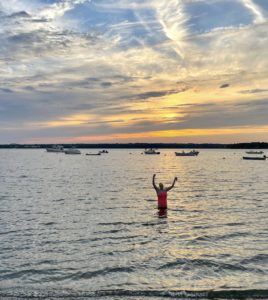
Getting started at Hadley Point
I stepped into the water at Hadley Point at exactly 7:27pm. After a few minutes of goggle adjustment and awaiting kayakers, I dove into the water and started swimming at 7:32pm. In those initial few moments of a long swim like this, I always have the same experience: excitement, coupled with “What the actual f*#k am I doing?” Feeling the support of the community on the beach and by my crew always gets me through these first few moments.
Our flotilla is always a pretty special sight to behold – and is one of the reasons why completing a swim in and around the waters of MDI is so special to me. The support and expertise, from MY community, are unmatched by any swim I could complete anywhere else in the world.
In the front of our flotilla, we had a navigation boat – The Galavant, piloted by Adam Wales, Jen Paigen-Wales, and their daughter. Kayakers on this leg, assisting with feeds and keeping me going in the right direction, were Brett Ciccotelli, Bob DeForrest, and Brian Armstrong. At the back of our flotilla was The Osprey from College of the Atlantic – piloted by Toby Stephenson. Onboard The Osprey was my husband, Mahandeva, in addition to Melissa Ossanna (my first observer for the swim), Mary Dudzik (my doctor), my daughter Iz, and Toby’s crew (Spencer and Ella). Gary Allen was also part of the flotilla, piloting his skiff.
After about 100-200 strokes, I felt myself settling into my initial pace (around 60 strokes per minute). I noticed, for the first time, the temperature of the water. On my first Round the Rock attempt in 2020, the water and air temperature were frigid from the start. My hands and my body never felt warm, throughout the entirety of the swim. However, on the evening of August 3rd, the water started at 64ºF and felt lovely. The air temperature was 67ºF. “I’m going to make it. If the water stays anything like this for at least half of the swim, I’m going to make it.”
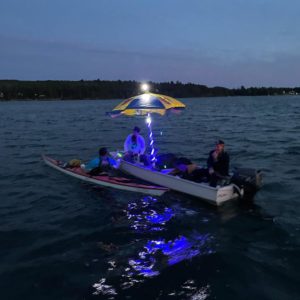
Tiki Boat love
My swim around MDI is divided into 20 different “legs.” The navigation boat follows waypoints to attempt to take me on the shortest possible route around the island. The first couple legs (about 3.6 miles) of the swim were uneventful. Hadley Point to Sand Point. Sand Point to Parker Point. There was a gorgeous sunset behind me and a light 4.5 mph breeze from the south. I had my first few feeds (warmed liquid nutrition) and laughed with joy into the water the first time I saw Gary Allen approach on his skiff (which we eventually referred to as the Tiki Boat).
Gary, Mahandeva, and the Tiki Boat were integral in passing off each one of my feeds to the kayakers. On this attempt, we decided to give me warm feeds for the entire swim, to help keep my body temperature up. I feed every 30-minutes, so the process looked something like this:
- Feeding kayaker would retrieve a warm bottle from the Tiki Boat.
- Feeding kayaker would get my attention, letting me know it was time for a feed.
- Feeding kayaker would drop the bottle into the water for me to retrieve. The bottles were attached to a line, glow stick, and piece of pool noodle – to help keep them floating and visible in the dark water.
- I would chug 10 oz. of liquid nutrition in about 30 seconds. The longer the feed, the more opportunity my body has to get cold. Feeding quick is key in cold water.
- I would drop the bottle back into the water and start swimming again. Either the feeding kayaker or the Tiki Boat would retrieve the bottle from the water.
- Gary would steer the Tiki Boat back to The Osprey so Mahandeva could prepare my next feed.
- The process repeated exactly like this . . .every 30-minutes.
No one should ever believe that long-distance open water swimming is a solo sport. My crew is beyond amazing and none of it would be possible without them.
“The sea can do craziness, it can do smooth, it can lie down like silk breathing or toss havoc shoreward; it can give gifts or withhold it all; it can rise, ebb, froth like an incoming frenzy of fountains, or it can sweet-talk entirely. As I can too, and so, no doubt, can you, and you.” – Mary Oliver
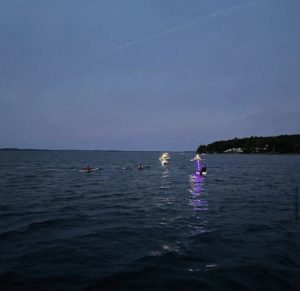
Night is falling. Parker Point is in the distance.
As we started to make the 3.5-mile crossing from Parker Point to Bar Island, conditions started to shift. The sky was now officially dark and the wind kicked up to about 20 mph from the W/SW. We had previously been in the lee of MDI, protected from the wind direction. But on this leg, we were a bit further off the coast from Hulls Cove, with less protection. My swimming route on this leg took me very close to Halftide Ledge and Bald Rock Ledge, which also contributed to the choppy water. At one point, during a feed, I looked up to Brett and said: “This chop is bullshit.” His response: “Yeah. It is bullshit. There is literally no other way to describe what is happening right now.” That felt very validating at that moment.
Despite the conditions and the fact that myself and the kayakers were getting pushed to the West and having to constantly course-correct, things were okay. The water was colder (hovering between 58-61ºF), but I was about 35-minutes ahead of schedule. I knew we were getting close to Bar Harbor, as I could make out the lighted buildings in the distance. Gradually, the lights disappeared, and I knew this meant we were officially behind Bar Island.
At this point in the swim, we had one kayaker (Brian Armstrong) rotate out of the flotilla and one kayaker (Alison Richardson) rotate in. Alison is a badass member of the winter/cold-water swimming group that I am a part of and just seeing her come into formation lifted my spirits. Alison moved into position to become my feeder kayaker for the next 6-7 miles.
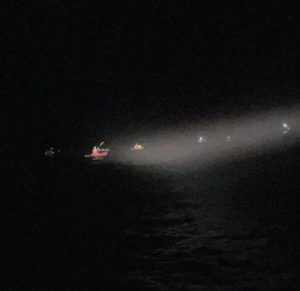
Spotlight guiding swimmer, kayaker, and skiff over Bar Island Ledge
I was protected from the wind as we passed behind Bar Island and Toby used the spotlight on The Osprey to direct me, the kayakers, and the skiff over the ledge off of Bar Island. Everything was relatively calm coming through Bar Harbor. As we passed by the Shore Path, I could hear people shouting and cheering. This was somewhere between 11:00-11:30pm. The water temperature was still holding steady at 58-61ºF.
Somewhere between Bar Harbor and The Breakwater, I had my first feed of (semi) solid food. For me personally, after swimming 6-10 miles, my body starts to get overwhelmed by the amount of sugar in normal endurance/athletic nutrition products. They start to make me nauseous, so we decided to try something new this year: congee. Congee is a traditional rice porridge eaten in Asian countries. This felt like an ideal food to try because it is not sweet, is filled with protein, could be served warm, and could be eaten with almost no chewing. Around this time, I also requested some anti-nausea medication. The rough water from Parker Point to Bar Island had definitely had an impact and I noticed that I was starting to feel ill.
“I get so lost in where I want to go. I forget that the place I’m in is already quite magical.” – Rupi Kaur
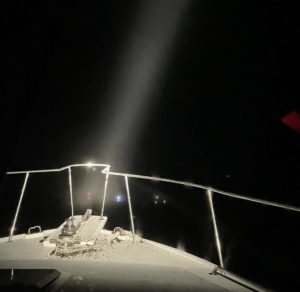
Light from The Osprey, trying to keep me oriented.
As we passed through The Breakwater, the wind was light (2 mph), and from the North. I was still 40-minutes ahead of schedule. However, moving out into the more exposed water, we began to feel the impact of a significant 3-4′ swell. At around 12:00am, I started throwing up due to the swell and an inability to focus on anything stable in the dark. The Osprey turned on their spotlight to try to help me better orient myself, but it was still difficult getting tossed around in the dark sea. It was around this point that I also noticed a significant drop in water temperature. By 1:30am, as we passed by Great Head, the temperature of the water was 53ºF.
During one of my feeds around this time, I looked up at the Tiki Boat and said in exasperation: “Is it going to be like this ALL NIGHT?!” (referring to the swells). Gary Allen responded with amazing advice that he has provided to me previously: “Just swim the mile you are in, Puranjot. Just swim the mile that you are in.” I finished my feed, put my head back down, and started swimming again.
I can’t say that up until this point I was doing a fantastic job of just swimming the mile that I was in. For the entirety of the swim, thus far, it had been incredibly difficult to find my rhythm and get into a “zone.” My stroke rate was pretty consistent, but I had to spend a fair amount of mental and physical energy dealing with that early chop on the water, and eventually the swells (also getting smacked in the head with lobster buoys does nothing for your swimming rhythm, in case anyone was wondering).
As I started to vomit after almost every feed, I also became fairly preoccupied with trying to stay warm. I began dreading my feeds because I just wanted to keep moving to keep my body temperature up. My mind was also thinking a lot about getting past where I had gotten to last year (just off of Otter Point). I was most definitely getting lost in where I wanted to go.
However, as I reflect back on this portion of the swim, there were beautiful – yes, darn-right magical – moments. Moments when I could just make out the dark mountains of MDI in the distance. Moments when my arm would pass through bioluminescence and sparkle. Moments when I could make out the stars in the night sky. I didn’t once think about swimming over depths of 130-150 feet in the dark, ominous ocean. And despite all of the challenges that were present, I can actually say that I really enjoyed swimming through the night.
As we approached Otter Cliffs around 2:30am, the wind was 14mph and coming from the S/SW. The crew could just barely make out the moon from behind the clouds. I could feel myself shivering and getting colder, as the water temperature was still around 54ºF. The following thought came into my head: “I’m just going to start swimming as fast as I can for as long as I can. I need to get my body warmed up.” I cranked up my stroke rate to 65-68. I could hear the Otter Cliff bell buoy and this gave me hope.
It was around Otter Point that Alison, Brett, and Bob headed off the water and Ron Beard and Ken Cline moved in as my kayak support.
“Just keep swimming until the sun comes up. Just keep swimming until the sun comes up.” This was the refrain running through my head.
“You survive by finding beauty in bleak and impossible situations.” – Alok Vaid-Menon
At 3:30am it was less than 30-minutes to Nautical Twilight and we were approaching Little Hunter’s Beach. The water was still 54ºF, but everyone on board knew that as we got closer to the shallower waters off East Bunker Ledge and Sutton Island, the water was likely to get warmer. At 4:00am, we passed Little Hunters Beach. I was officially past the point where I had to stop the swim in 2020.
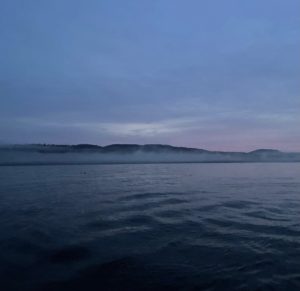
Dawn has broken! Less than a mile from Sutton Island.
However, at around 4:30am, my stroke rate had decreased again and Mary came out on the skiff to access my ability to continue on with the swim. I was shaking heavily during each feed and had been throwing up consistently for the last 4.5 hours. I appreciate Mary so much for her care and expertise – and also for our ability to work in partnership. She said: “Puranjot, I’m thinking about calling the swim. But, I want to check in with you and see how you are feeling. I need you to give me some feedback.” I was thankfully able to answer correctly the question she used to assess my mental state (“What is your daughter’s birthday”). It didn’t feel like time to stop yet. “Give me one more half-hour. Let’s check in during my next feed.”
Somehow I willed myself to up my stroke rate again and found another hidden reserve of energy. My legs felt very heavy and almost immobile in the water, but I managed to start kicking them harder. We were 1-mile from Sutton Island.
Off to my right, I could see light in the sky. Although we never experienced a full sunrise on August 4th, due to the fog, for the briefest of moments I saw pink in the sky. It was officially morning. I had made it through the night. It was beautiful.
“That even as we grieved, we grew. That even as we hurt, we hoped. That even as we tired, we tried.” – Amanda Gorman
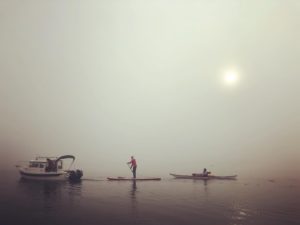
Thick fog on the morning of August 4th
5:30ish am. Our flotilla was just off Sutton Island and a new team of support kayakers came into place – Kelly Fernald and Allison Reid. I have swum alongside Allison and Kelly many times and their presence is hugely comforting and a boost to my spirits. But, the fog was dungeon thick – everyone around me on the boats was bundled in warm hats and jackets. During a feed, I looked up at Mahandeva and said, “Where the f*#k is the sun??!”
One arm in front of the other. Another half-hour. Give me another half-hour. I can do anything for one more half-hour.
At some point, something shifted dramatically in my body. I’m not sure if it was the cold or the sheer lack of calories I had been able to keep down, but the lower half of my body completely seized up. This had also started to happen several hours earlier, as I made the crossing from Otter Point to Sutton Island, but I had somehow forced myself to kick my legs harder. This time it felt completely different. My legs just wouldn’t move no matter how hard I tried.
I am very much a self-proclaimed upper-body swimmer and when I had a knee injury earlier in the summer, I spent many days training without the use of my legs. However, when doing this type of training, you almost always have a pull-buoy between your legs (this little piece of molded foam that keeps the bottom half of your body floating). Honestly, because ocean water is so buoyant and I don’t actually kick very heavily, I feel like I could complete almost any swim with a pull-buoy in place. However, without a pull-buoy and without the ability to kick, your legs begin to sink and your body position in the water becomes compromised. You are no longer streamlined – rather you are towing a body that has become like a snowplow behind you in the water.
My heart knew this was, finally, the beginning of the end. I had made it so far. So much farther than last year. But without the use of my legs and without the speed needed to generate heat, I knew I wasn’t going to be able to continue much further. With this realization, huge tears of grief came pouring out of my eyes and I started audibly crying down into the water. With each stroke and breath to the right, I could see Kelly watching me – with concern and care written across her face.
Another 30-minutes went by and Kelly called me over to the boat for a feed. After a little bobble with one of my water bottles, she handed me a GU packet. “Kelly – I can’t move my legs. I can’t move my legs.” Alison maneuvered close by on her paddleboard and they both got the attention of Mary, on The Osprey. I was shaking (Mahandeva described it as “convulsing.”) I can’t recall all that was said, but everyone was in agreement – the swim was over. 22-miles. 11-hours.
Kelly immediately tossed me a PFD that I managed to get my arms into. Alison paddled up behind me and kneeled down on her paddleboard. The tears came powerfully and I cried, as she held my exhausted upper body in her arms.
“Place a hand on your chest. Take a deep breath. Feel your belly fill up. Hold the inhale for four counts. Feel the suspension. Now exhale for eight counts. Feel your heart beating in your chest. You are alive. You are here. Look around you. What is the most beautiful thing that you can see right now? Look at it for a moment. Notice its color, and shape, the way the light falls on it. Let yourself wonder at it. No matter what is happening out there in the world right now – no matter how dark or violent or cruel – this beautiful thing also exists. The world right here is just as real as the world out there. Take another deep breath. Notice how it’s a little easier. Now – who can share this beautiful thing with you?” – Valarie Kaur
After being pulled from the water, there is a flurry of activity. My team jumps into action, in an effort to warm my cold body. The tears flow freely. I am aware of people talking to me. I am aware of hot water bottles placed strategically around my body (although I’m too cold to feel them initially). As my body temperature rises slightly, I am aware of my dear friends Melissa and Gail Gladstone rubbing my body and “bear-hugging” me to add additional warmth. I am aware of Gary Allen’s pea coat being placed over me, as an additional blanket. I am aware of Mahandeva supporting my head and talking to me. “I tried as hard as I could,” I say between sobs and trying to slow my shivering and breathing. I am aware of the immense amount of love that is capable of all of these amazing individuals.
A month later, I find myself driving to the lake early in the morning, reflecting on this swim, reflecting on my swim in 2020. Questions fill my mind, rapid-fire. Why, do I keep doing this? Why do I continue to train every day? Why do I put my body through the discomfort? Why do I spend time away from the people I love? Why do they support me in that? Why go through all of the logistics and the planning? Why choose to swim through the sea at night? Why put my body in the distinct possibility of getting hypothermia? Will I do this a third time? A fourth time? A fifth time? For how many ever times it takes?
The answer, of course, is yes. But why?
Physically, I have put my body through a lot. And not just in this moment or for this swim. At other points in my life, I wasn’t always able to extend loving kindness to my body, for one reason or another (reasons that this blog post simply does not have the time or the space to explore). Because I am predisposed to that, one might argue that this intense amount of training and intense amount of challenge could be more of the same. I understand that some might see it that way.
There have also been times in my life when my body was put through traumas that were not my choice – when I didn’t get to choose whether or not the pain or discomfort would stop. Abuses at the hands of my father and my uncle that I was only able to uncover and begin to process fully in my adult years.
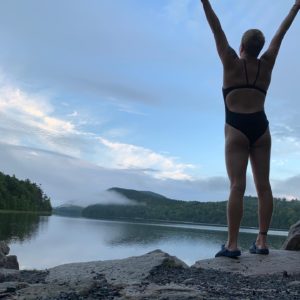
Joy. Joy and wonder.
But, that is what makes this experience so different. The choice that I have to continue on this journey or to stop. I can invite myself into these deep and dark and scary places and know that I have the capacity to face them. Simultaneously, I know I have the power to stop if that is what my body needs at any given moment. I didn’t always feel like I had that choice. To have it now is huge and liberating.
In the water, in the weightlessness, is where I have found this liberation. When I swim, my physical body almost drops away, and yet, I’m keenly aware of every movement and every sensation. I’m suspended in space. Held, supported, cradled, enveloped. I dare say that I feel loved by the water. It is something that is so vast and expansive. In that space of being held by the vastness, I can continually return to who it is I am. Deep down. At my core. Everything else – the past traumas, the challenge, the heartache – it simply drops away. Just this breath. Just this breath. Just. This. Breath.
So, that is what I have learned. That is what makes me return to the water every morning and to this challenge – as many times as it takes. Even the difficult, even the most heart-wrenching moments can hold us – giving way to moments of wonder and joy. For me, swimming is a constant reminder to choose joy over sorrow. I wish to share that beautiful thing with you and to remind us all to just “swim” the “mile” we are in.

Such beautiful reflections, Puranjot. Thanks for sharing.
Oh Puranjot, thank you for the gift of these beautiful words, “swimming lessons.” You are a much needed very bright light in these very dark times. I hope I can spend time at sea with you next time!
Thank you for sharing!!
Following your journey has been incredible, but to have been fortunate enough to read what you were thinking and feeling brought it to the next level!
Your strength, perseverance and straight up bad ass attitude towards life- goals-overcoming the past- is inspirational to say the least!!
Thank you for keeping on and moving ahead. Thank you for your thoughts. Sometimes you just have to do it because it is THERE. Thank you.
Thank you. Thank you. Thank you. A million times over, thank you for your courage Puranjot. Thank you for sharing your journey. Thank you for acknowledging the love and support that surrounds you, not only the water, but the people. Sitting here in tears of gratitude for the fact that you took the time to write and share all of this. May we all continue to “swim the mile we’re in”. Love to you and to Mahandeva.